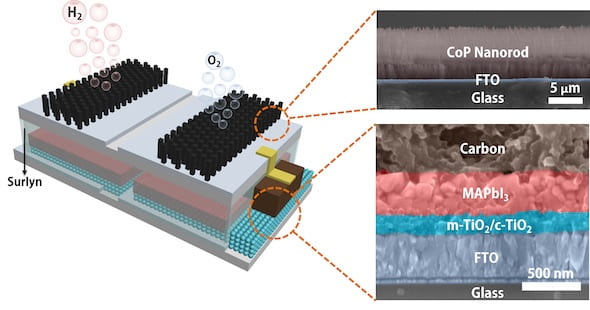

Plants use the process of photosynthesis to generate chemical energy from sunlight. Likewise, a new energy-producing device developed at Rice University is triggered by sunlight. Image via Didgeman/ Pixabay.
Rice University researchers have created an efficient, low-cost device that splits water to produce hydrogen fuel.
The device was developed by the Brown School of Engineering lab of Jun Lou, materials scientist at Rice University, and his team. It integrates catalytic electrodes and perovskite solar cells that, when triggered by sunlight, produce electricity. The current flows to the catalysts that split water molecules into hydrogen and oxygen, with a sunlight-to-hydrogen efficiency as high as 6.7%.
Hydrogen can be stored and used as fuel.
This sort of catalysis isn’t new, but the lab packaged a perovskite layer and the electrodes into a single modular unit that, when dropped into water and placed in sunlight, produces hydrogen with no further input.

Here’s what the new device looks like. Cross-sections show the structure of an integrated, solar-powered catalyst that splits water into hydrogen fuel and oxygen. Immersed in water, the device produces fuel when exposed to sunlight. Image via Jia Liang/ Rice University.
The device was described by lead author Lou, postdoctoral fellow Jia Liang and their colleagues in the peer-reviewed journal ACS Nano April 29, 2020. The module is a self-sustaining producer of hydrogen, which can be used for fuel. The researcher say it should be simple to produce in bulk. Lou described the device in a statement:
The concept is broadly similar to an artificial leaf. What we have is an integrated module that turns sunlight into electricity that drives an electrochemical reaction. It utilizes water and sunlight to get chemical fuels.
Perovskites are crystals with cubelike lattices that are known to harvest light. The most efficient perovskite solar cells produced so far achieve an efficiency above 25%, but the materials are expensive and tend to be stressed by light, humidity and heat. Lou said:
Jia has replaced the more expensive components, like platinum, in perovskite solar cells with alternatives like carbon. That lowers the entry barrier for commercial adoption. Integrated devices like this are promising because they create a system that is sustainable. This does not require any external power to keep the module running.
The key component may not be the perovskite but the polymer that encapsulates it, protecting the module and allowing to be immersed for long periods, Liang said.
Others have developed catalytic systems that connect the solar cell outside the water to immersed electrodes with a wire. We simplify the system by encapsulating the perovskite layer with a Surlyn (polymer) film.
The patterned film allows sunlight to reach the solar cell while protecting it and serves as an insulator between the cells and the electrodes, Liang said. Lou added:
With a clever system design, you can potentially make a self-sustaining loop. Even when there’s no sunlight, you can use stored energy in the form of chemical fuel. You can put the hydrogen and oxygen products in separate tanks and incorporate another module like a fuel cell to turn those fuels back into electricity.
The researchers said they will continue to improve the encapsulation technique as well as the solar cells themselves to raise the efficiency of the modules.
Bottom line: Rice University researchers have designed a device which, when immersed in water and exposed to sunlight, generates hydrogen and oxygen.
Source: A Low-Cost and High-Efficiency Integrated Device toward Solar-Driven Water Splitting
from EarthSky https://ift.tt/2Z1ns6f


Plants use the process of photosynthesis to generate chemical energy from sunlight. Likewise, a new energy-producing device developed at Rice University is triggered by sunlight. Image via Didgeman/ Pixabay.
Rice University researchers have created an efficient, low-cost device that splits water to produce hydrogen fuel.
The device was developed by the Brown School of Engineering lab of Jun Lou, materials scientist at Rice University, and his team. It integrates catalytic electrodes and perovskite solar cells that, when triggered by sunlight, produce electricity. The current flows to the catalysts that split water molecules into hydrogen and oxygen, with a sunlight-to-hydrogen efficiency as high as 6.7%.
Hydrogen can be stored and used as fuel.
This sort of catalysis isn’t new, but the lab packaged a perovskite layer and the electrodes into a single modular unit that, when dropped into water and placed in sunlight, produces hydrogen with no further input.

Here’s what the new device looks like. Cross-sections show the structure of an integrated, solar-powered catalyst that splits water into hydrogen fuel and oxygen. Immersed in water, the device produces fuel when exposed to sunlight. Image via Jia Liang/ Rice University.
The device was described by lead author Lou, postdoctoral fellow Jia Liang and their colleagues in the peer-reviewed journal ACS Nano April 29, 2020. The module is a self-sustaining producer of hydrogen, which can be used for fuel. The researcher say it should be simple to produce in bulk. Lou described the device in a statement:
The concept is broadly similar to an artificial leaf. What we have is an integrated module that turns sunlight into electricity that drives an electrochemical reaction. It utilizes water and sunlight to get chemical fuels.
Perovskites are crystals with cubelike lattices that are known to harvest light. The most efficient perovskite solar cells produced so far achieve an efficiency above 25%, but the materials are expensive and tend to be stressed by light, humidity and heat. Lou said:
Jia has replaced the more expensive components, like platinum, in perovskite solar cells with alternatives like carbon. That lowers the entry barrier for commercial adoption. Integrated devices like this are promising because they create a system that is sustainable. This does not require any external power to keep the module running.
The key component may not be the perovskite but the polymer that encapsulates it, protecting the module and allowing to be immersed for long periods, Liang said.
Others have developed catalytic systems that connect the solar cell outside the water to immersed electrodes with a wire. We simplify the system by encapsulating the perovskite layer with a Surlyn (polymer) film.
The patterned film allows sunlight to reach the solar cell while protecting it and serves as an insulator between the cells and the electrodes, Liang said. Lou added:
With a clever system design, you can potentially make a self-sustaining loop. Even when there’s no sunlight, you can use stored energy in the form of chemical fuel. You can put the hydrogen and oxygen products in separate tanks and incorporate another module like a fuel cell to turn those fuels back into electricity.
The researchers said they will continue to improve the encapsulation technique as well as the solar cells themselves to raise the efficiency of the modules.
Bottom line: Rice University researchers have designed a device which, when immersed in water and exposed to sunlight, generates hydrogen and oxygen.
Source: A Low-Cost and High-Efficiency Integrated Device toward Solar-Driven Water Splitting
from EarthSky https://ift.tt/2Z1ns6f

Aucun commentaire:
Enregistrer un commentaire